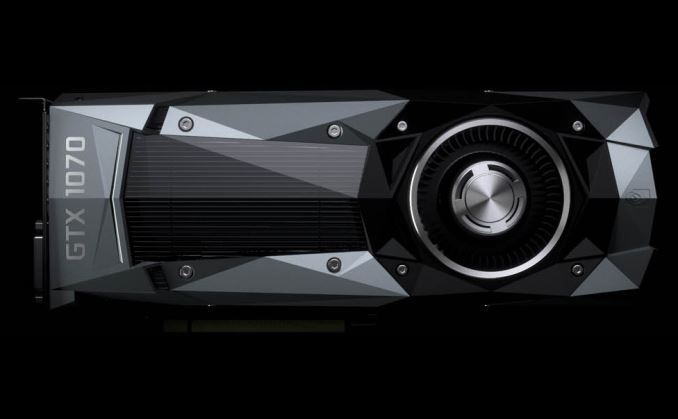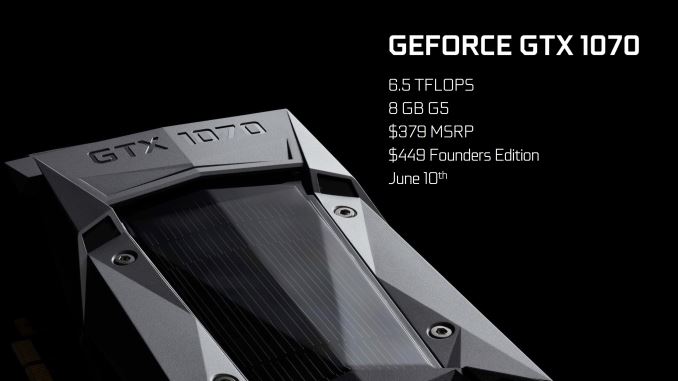NVIDIA Posts Full GeForce GTX 1070 Specifications: 1920 CUDA Cores Boosting to 1.68GHz
by Ryan Smith on May 18, 2016 10:15 PM EST
Back when NVIDIA first announced the GeForce GTX 1080 earlier this month, they also briefly announced that the GTX 1070 would be following it. The GTX 1070 would follow the GTX 1080 by two weeks, and presumably to keep attention focused on the GTX 1080 at first, NVIDIA did not initially reveal the full specifications for the card. Now with the GTX 1080 performance embargo behind them – though cards don’t go on sale for another week and a half – NVIDIA has posted the full GTX 1070 specifications over on GeForce.com.
| NVIDIA GPU Specification Comparison | ||||||
| GTX 1080 | GTX 1070 | GTX 970 | GTX 770 | |||
| CUDA Cores | 2560 | 1920 | 1664 | 1536 | ||
| Texture Units | 160 | 120 | 104 | 128 | ||
| ROPs | 64 | 64 | 56 | 32 | ||
| Core Clock | 1607MHz | 1506MHz | 1050MHz | 1046MHz | ||
| Boost Clock | 1733MHz | 1683MHz | 1178MHz | 1085MHz | ||
| TFLOPs (FMA) | 8.9 TFLOPs | 6.5 TFLOPs | 3.9 TFLOPs | 3.3 TFLOPs | ||
| Memory Clock | 10Gbps GDDR5X | 8Gbps GDDR5 | 7Gbps GDDR5 | 7Gbps GDDR5 | ||
| Memory Bus Width | 256-bit | 256-bit | 256-bit | 256-bit | ||
| VRAM | 8GB | 8GB | 4GB | 2GB | ||
| FP64 | 1/32 | 1/32 | 1/32 | 1/24 | ||
| TDP | 180W | 150W | 145W | 230W | ||
| GPU | GP104 | GP104 | GM204 | GK104 | ||
| Transistor Count | 7.2B | 7.2B | 5.2B | 3.5B | ||
| Manufacturing Process | TSMC 16nm | TSMC 16nm | TSMC 28nm | TSMC 28nm | ||
| Launch Date | 05/27/2016 | 06/10/2016 | 09/18/14 | 05/30/13 | ||
| Launch Price | MSRP: $599 Founders $699 |
MSRP: $379 Founders $449 |
$329 | $399 | ||
Previously disclosed at 6.5 TFLOPs of compute performance, we now know how NVIDIA is getting there. 15 of 20 SMs will be enabled on this part, representing 1920 CUDA cores. Clockspeeds are also slightly lower than GTX 1080, coming in at 1506MHz for the base clock and 1683MHz for the boost clock. Overall this puts GTX 1070’s rated shader/texture/geometry performance at 73% that of GTX 1080’s, and is a bit wider of a gap than it was for the comparable GTX 900 series cards.
However on the memory and ROP side of matters, the two cards will be much closer. The GTX 1070 is not shipping with any ROPs or memory controller channels disabled – GTX 970 style or otherwise – and as a result it retains GP104’s full 64 ROP backend. Overall memory bandwidth is 20% lower, however, as the GDDR5X of GTX 1080 has been replaced with standard GDDR5. Interestingly though, NVIDIA is using 8Gbps GDDR5 here, a first for any video card. This does keep the gap lower than it otherwise would have been had they used more common memory speeds (e.g. 7Gbps) so it will be interesting to see how well 8Gbps GDDR5 can keep up with the cut-down GTX 1070. 64 ROPs may find it hard to be fed, but there will also be less pressure being put on the memory subsystem by the SMs.
Meanwhile as is usually the case for x70 cards, GTX 1070 will have a lower power draw than its fully enabled sibling, with a shipping TDP of 150W. Notably, the difference between the GTX 1080 and GTX 1070 is larger than it was for the 900 series – where it was 20W – so we’re going to have to see if GTX 1070 ends up being TDP limited more often than GTX 1080 is. In that sense TDP is somewhat arbitrary – its purpose is to set a maximum power consumption for cooling and power delivery purposes – and I’m not surprised that NVIDIA wants to stay at 150W or less for the x70 series after the success that was the GTX 970.
Like the GTX 1080, the GTX 1070 will be launching in two configurations. The base configuration is starts at $379 and will feature (semi) custom partner designs. Meanwhile as previously disclosed, NVIDIA will be offering a Founders Edition version of this card as well. The Founders Edition card will be priced at $449 – a $70 premium – and will be available on day one, whereas this is not guaranteed to be the case for custom cards.
The GTX 1070 Founders Edition card will retain the basic stylings of the GTX 1080, including NVIDIA’s new angular shroud. However I have received confirmation that as this is a lower TDP card, it will not get the GTX 1080’s vapor chamber cooler. Instead it will use an integrated heatpipe cooler similar to what the reference GTX 980 used.











137 Comments
View All Comments
fanofanand - Thursday, May 19, 2016 - link
Having "premium" editions of a product is not price gouging. I get that the average reader here is closer to being an engineer than an economist, but the ignorance is a bit shocking. The only way to have actual gouging is if the product is a necessity, which a cutting edge graphics card is not. Rather than complain that a company is maximizing their profits, just go AMD. That's what I did. But wit, they "gouge" when they can too.....the great thing about free markets, is that eventually all non-necessary goods and services will eventually reach a price equilibrium base on the market's reaction to the pricing. This is common sense folks.lornecaine - Thursday, May 19, 2016 - link
If you really studied economics, you would know that a perfect equilibrium is a fantasy of theory and that almost all markets suffer from the distortions of market power.Murloc - Thursday, May 19, 2016 - link
it's not a fantasy, it's a theory that approximates reality in a not very good way.The principle stands, if AMD can come up with a similar card and starts a price war, prices go down.
The reality is that AMD always come up short and the price is distorted but that's not the point here. The point is that some people are calling the FE price gouging, when in reality it's just a common tactic of capturing the higher reservation price of certain customers.
Publishers do the same with hardcover books, which have a negligible cost difference but a huge price difference from the softcover books that come a few months later.
If I was ready to start selling a long-awaited item but only in small quantities at the beginning, I would do this too.
Actually nvidia is even more honest than the publishers because they aren't withholding parts on purpose, they're simply ramping up the supply.
xthetenth - Friday, May 20, 2016 - link
AMD only comes up short in marketing, the most compelling products of the past five years are pretty much all theirs. The 7970 is still roughly competitive at a level right around 200, the 290/390 is competing well against the 970 while the 780 and 780 Ti it launched against have fallen off into a shameful demise. Meanwhile NV is the brand behind the Titan, which has tanked horribly against the 290X, the 960 2 GB which is already constrained by its memory, and has made multiple generations that start competitive with AMD and age so poorly they need a replacement years sooner, directly costing their customers money.Murloc - Thursday, May 19, 2016 - link
actually those readers are closer to being entitled angry nerds than to being engineers because engineers always have to think about cost, and so economics aren't that foreign to them.xthetenth - Friday, May 20, 2016 - link
Apparently noting that NV's margins are climbing to the sky makes one an entitled angry nerd.I guess that means you have Stockholm syndrome.
rocky12345 - Thursday, May 19, 2016 - link
I just posted about the inflating prices etc. I wanted to say I am not a fanboy I buy what ever suites my needs at the time. The last time it was a pair of Sapphire 390X 8GB cards this time around if it pans out that the GTX 1070 8GB is pretty fast & can at least come close to or match the 980 Ti in games I will pick up a pair of those. Some will say oh just get 1 card that is better but why would I go for slower when I already have a setup that will be as fast as a GTX 1080 with my 2 390x cards in crossfire overclocked to 1270Mhz each and memory outputting at 435GB's a second on each card. My idea is the GTX 1070 will be or at least should be a lot faster than a single 390x so for those times when SLI or crossfire does not work I have a very strong base card for those times and a overclocked GTX 1070 should be able to smoke a 390x overclocked in everything. SO no not a fanboy buy whats a good value at the time. I use at the moment AMD's VSR maxed to what they support on my projector so I am looking forward to trying out Nvidia's DSR to see how it works as well.fanofanand - Thursday, May 19, 2016 - link
Hard to call an incremental step in performance that costs nearly $1,000 a "value play" but that's the beauty of free markets. What seems like a value to one, could be considered foolish to another. They are both right.rocky12345 - Thursday, May 19, 2016 - link
You are right & I may have played right into it by buying cards that were a small step up from the last ones that were made. In my defense I came from Nvidia Geforce GTX 680's SLI OC'd to the max so going to the 390x's was a huge jump in performance for my gaming needs. I also sold my 680 4GB cards sold for $265 CAD each to a friend so I had $530 CAD from that & I splurged & added the rest to get my 2 390x cards. He was happy & so was I win win for both of us.just4U - Thursday, May 19, 2016 - link
Only problem for you is what will those prices on the 1070 be like here in Canada. Yeah sure .. we recently got a price drop on the 970/80s but... it's still not in line for what it should be. Plus with demand I can easily see those 1070s hitting $600 CAD.